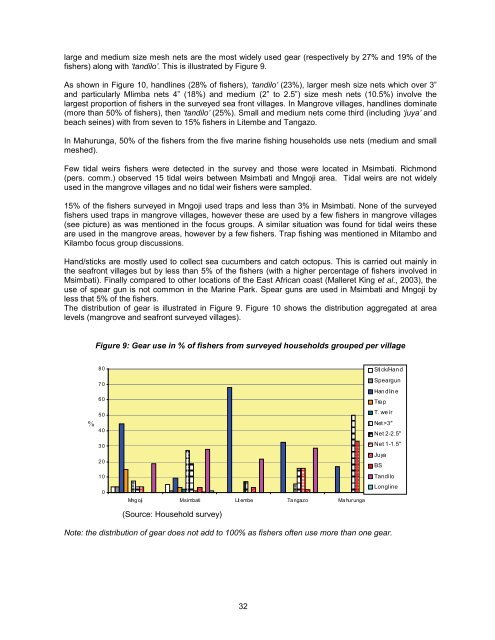a socio-economic baseline assessment of the mnazi bay - IUCN
a socio-economic baseline assessment of the mnazi bay - IUCN
a socio-economic baseline assessment of the mnazi bay - IUCN
You also want an ePaper? Increase the reach of your titles
YUMPU automatically turns print PDFs into web optimized ePapers that Google loves.
large and medium size mesh nets are <strong>the</strong> most widely used gear (respectively by 27% and 19% <strong>of</strong> <strong>the</strong><br />
fishers) along with ‘tandilo’. This is illustrated by Figure 9.<br />
As shown in Figure 10, handlines (28% <strong>of</strong> fishers), ‘tandilo’ (23%), larger mesh size nets which over 3”<br />
and particularly Mlimba nets 4” (18%) and medium (2” to 2.5”) size mesh nets (10.5%) involve <strong>the</strong><br />
largest proportion <strong>of</strong> fishers in <strong>the</strong> surveyed sea front villages. In Mangrove villages, handlines dominate<br />
(more than 50% <strong>of</strong> fishers), <strong>the</strong>n ‘tandilo’ (25%). Small and medium nets come third (including ‘juya’ and<br />
beach seines) with from seven to 15% fishers in Litembe and Tangazo.<br />
In Mahurunga, 50% <strong>of</strong> <strong>the</strong> fishers from <strong>the</strong> five marine fishing households use nets (medium and small<br />
meshed).<br />
Few tidal weirs fishers were detected in <strong>the</strong> survey and those were located in Msimbati. Richmond<br />
(pers. comm.) observed 15 tidal weirs between Msimbati and Mngoji area. Tidal weirs are not widely<br />
used in <strong>the</strong> mangrove villages and no tidal weir fishers were sampled.<br />
15% <strong>of</strong> <strong>the</strong> fishers surveyed in Mngoji used traps and less than 3% in Msimbati. None <strong>of</strong> <strong>the</strong> surveyed<br />
fishers used traps in mangrove villages, however <strong>the</strong>se are used by a few fishers in mangrove villages<br />
(see picture) as was mentioned in <strong>the</strong> focus groups. A similar situation was found for tidal weirs <strong>the</strong>se<br />
are used in <strong>the</strong> mangrove areas, however by a few fishers. Trap fishing was mentioned in Mitambo and<br />
Kilambo focus group discussions.<br />
Hand/sticks are mostly used to collect sea cucumbers and catch octopus. This is carried out mainly in<br />
<strong>the</strong> seafront villages but by less than 5% <strong>of</strong> <strong>the</strong> fishers (with a higher percentage <strong>of</strong> fishers involved in<br />
Msimbati). Finally compared to o<strong>the</strong>r locations <strong>of</strong> <strong>the</strong> East African coast (Malleret King et al., 2003), <strong>the</strong><br />
use <strong>of</strong> spear gun is not common in <strong>the</strong> Marine Park. Spear guns are used in Msimbati and Mngoji by<br />
less that 5% <strong>of</strong> <strong>the</strong> fishers.<br />
The distribution <strong>of</strong> gear is illustrated in Figure 9. Figure 10 shows <strong>the</strong> distribution aggregated at area<br />
levels (mangrove and seafront surveyed villages).<br />
Figure 9: Gear use in % <strong>of</strong> fishers from surveyed households grouped per village<br />
%<br />
80<br />
70<br />
60<br />
50<br />
40<br />
30<br />
20<br />
10<br />
0<br />
Mngoji Msimbati Lit embe Tangazo Mahurunga<br />
(Source: Household survey)<br />
Sti ck/Han d<br />
Speargun<br />
Handline<br />
Tra p<br />
T. we ir<br />
Net >3"<br />
Net 2-2.5"<br />
Net 1-1.5"<br />
Juya<br />
BS<br />
Tandilo<br />
Longline<br />
Note: <strong>the</strong> distribution <strong>of</strong> gear does not add to 100% as fishers <strong>of</strong>ten use more than one gear.<br />
32
















